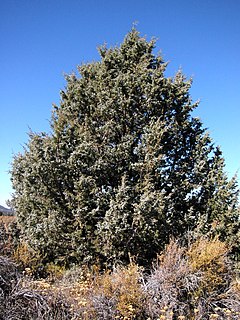Western juniper
| Juniperus occidentalis | |
|---|---|
 |
|
| Tree of var. occidentalis, Lava Beds National Monument | |
| Scientific classification | |
| Kingdom: | Plantae |
| Division: | Pinophyta |
| Class: | Pinopsida |
| Order: | Pinales |
| Family: | Cupressaceae |
| Genus: | Juniperus |
| Species: | J. occidentalis |
| Binomial name | |
|
Juniperus occidentalis Hook. |
|
 |
|
| Natural range | |
Juniperus occidentalis (western juniper or Sierra juniper) is a shrub or tree native to the western United States, growing in mountains at altitudes of 800–3,000 metres (2,600–9,800 ft) and rarely down to 100 metres (330 ft).
The Juniperus occidentalis shoots are of moderate thickness among junipers, 1-1.6 mm diameter. The leaves are arranged in opposite decussate pairs or whorls of three; the adult leaves are scale-like, 1–2 mm long (to 5 mm on lead shoots) and 1-1.5 mm broad. The juvenile leaves (on young seedlings only) are needle-like, 5–10 mm long. The cones are berry-like, 5–10 mm in diameter, blue-brown with a whitish waxy bloom, and contain one to three seeds; they are mature in about 18 months. The male cones are 2–4 mm long, and shed their pollen in early spring.
The cones are an important food for several birds, including American robin, Clark's nutcracker, phainopepla and cedar waxwing; these digest the fleshy cone scales and disperse the seeds in their droppings. The plants often bear galls caused by the juniper tip midge Oligotrophus betheli (Bibionomorpha: Cecidomyiidae); these are violet-purple fading to brown, 1–2 cm diameter, with dense modified spreading scale-leaves 6–10 mm long and 2–3 mm broad at the base.
There are two Juniperus occidentalis varieties, treated as subspecies by some botanists:
The Bennett Juniper in the Stanislaus National Forest of California is considered the oldest and largest example at possibly 3000 years old, with a height of 26 m and a diameter of 3.88 m.
Juniperus occidentalis usually occurs on dry, rocky sites where there is less competition from larger species like ponderosa pine and coast Douglas-fir. In very exposed positions at high altitude, they can assume a krummholz habit, growing low to the ground even when mature with a wide trunk. Hybrids with Juniperus osteosperma are occasionally found.
...
Wikipedia

